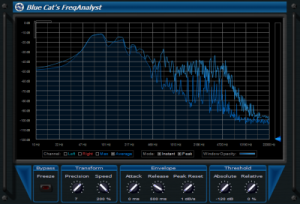Digital Music Jargon Explained – FFT
This third episode of the DMJ series deals with the Fast-Fourier Transform, which is basically an analogue/digital processing algorithm. The first two episodes covered dithering and oversampling, but for more info on FFT, read on…![]()
Introducing the FFT

The Fast Fourier Transform is an optimisation of the Discrete Fourier Transform – itself being a digital adaptation of the Fourier Transform, which originated in the analogue domain.
Fourier originally determined that it is possible to model periodic waveforms as the sum of harmonically-related sine waves, and the DFT brings this process into the digital domain. The FFT is basically a faster method of applying this DFT transformation, as it removes certain redundant calculations from the mix.
FFT Visualisations At Work
Many digtial audio workstations feature some form of waveform visualisation, and it is likely that a FFT graph forms a part of such representations. FFT visualisations are also featured in plugins such as izotope’s Ozone mastering suite and Blue Cat’s free FreqAnalyst.
Basically, the FFT breaks down the complex audio signal (your audio) into a set of underlying sine waves. It does this by probing the source with another sine wave until it finds a sine that matches.
Making Waves With FFT
If you multiply two sine waves of identical frequency together, the resultant wave’s average value is proportional to the source sines’ amplitude – but if you multiply two sines of different frequencies, then the average value will be zero.
So, by probing the source with a test tone and varying its frequency, the constituent sines can then be determined. Check out this page on Earlevel for more details on this process.
So what does this mean for producers? Well, having an accurate graphical representation of dominant frequencies in your recording can help with determining where your mix could use some corrective EQ. Although you should always trust your ears, it’s true that a graphical aid can be very helpful – particularly when you’re just learning the ins and outs of equalisation techniques…